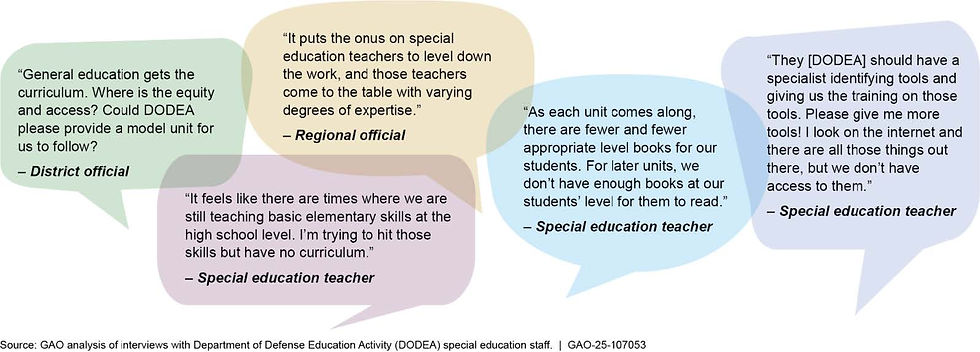Underserved and Overlooked: Special Education Gaps in DOD Schools
- Jeremy Hilton

- Jul 3
- 4 min read
By Jeremy Hilton
Photography by Jason Ragucci

On April 17, 2025, the Government Accountability Office (GAO) released a critical report: “Special Education: Improved Allocation of Resources Could Help DOD Education Activity Better Meet Students' Needs.”
While the GAO’s recommendations are thoughtful and measured—as is customary—the most revealing insights lie deeper in the report. The real story emerges in the candid, often unsettling comments from DODEA staff and parents. These voices provide a sobering view of the human impact of systemic shortfalls in special education within Department of Defense schools, especially overseas. The GAO’s report sheds light on longstanding issues with special education gaps in DOD schools, especially for families stationed overseas.
On Systemic Turnover and Staff Instability
"staff said that they have had more than 14 different administrators in the last 4 years.”
“teachers said that they had a student who did not receive required special education services for months because the school lost the student’s paperwork during an administrator turnover.”
“it took about 6 months for their child to get an IEP because 'things fell through the cracks' ”
On Lack of Instructional Materials
"One teacher emphasized that they are “not a curriculum developer.”
“I feel like I am constantly reinventing the wheel to adapt the curriculum.”

On Gaps in Service Delivery Overseas
“...because our location only has three physical therapists, students receive their required IEP service minutes in one week rather than spread out over a month, making it more difficult for students to build skills."
"we found delays in service delivery for students in 44 of the 114 schools overseas for the 2022–2023 school year. On average, it took between 37 and 99 days to resolve delays for different services."

On Inconsistent Policies Across Schools
“When you talk to folks at other schools, they do things different. You can do what works for your school, but that may not be best practice for students.”
“There is no conformity. The two schools I work at are night and day.”
"School staff from more than half the schools we visited (eight of 14) also expressed concern that they may be out of compliance with IDEA or DOD policy."

On Lack of Crisis Training for Paraeducators
“Only certain people in the schools receive the [crisis] training. Administrators are trained, but they don’t always show up when they are needed. It is dangerous.”
“paraeducators must “get lucky” that the teachers they work with provide on-the-job training”
[paraeducator] I was "thrown into the job to sink or swim.’”
On Staffing Mismatches and Service Gaps
“One teacher is supposed to serve a certain number of students, but a certain number of students doesn’t necessarily equal a certain number of hours.”
“We are grouping students together to make service delivery work...but it means losing individualized attention that was helping them progress.”
On Insufficient Guidance
"In nearly all (13 of 14) schools we visited, DODEA school staff said that they need more clarity and detail on how to implement DOD’s special education policies."
"regional officials we spoke with told us that DODEA does not have procedural guidance for special education."
Final Thoughts on Special Education Gaps In DoD Schools
The GAO’s investigation reveals a system under strain—marked by understaffing, inconsistent training, and delays in essential services. These failures are particularly acute overseas, where resources are even more limited. This reality starkly contrasts with the praise DODEA schools received from The New York Times for their general education programs. It raises an important question: Why are students with disabilities receiving such disparate treatment?
Behind the data are real stories—of students missing vital therapy, of paraeducators physically harmed on the job, of teachers overwhelmed by needs they’re not resourced to meet. These aren't just operational challenges. They are signals that the system is failing the very families who depend on it most.
DODEA's commitment to providing a free and appropriate public education is clear in policy—but in practice, it falters. The GAO’s recommendations aren’t optional upgrades. They are urgent fixes.
What’s at stake isn’t just legal compliance—it’s the dignity, safety, and success of thousands of military students already facing substantial hurdles. The solutions are visible. What remains is the will to act.
“Good ideas are not adopted automatically. They must be driven into practice with courageous impatience.” ~ Retired Adm. Hyman Rickover
Read the full GAO Report on Special Education:
Improved Allocation of Resources Could Help DOD Education Activity Better Meet Students' Needs here: https://www.gao.gov/products/gao-25-107053

*Response from DoDEA: The Department of Defense Education Activity (DoDEA) remains firmly committed to delivering high-quality, individualized education to students with disabilities across our global school system. We appreciate the GAO’s engagement and have taken meaningful steps to address its recommendations while balancing operational feasibility and student-centered outcomes.
As part of our ongoing commitment to continuous improvement, we have already undertaken several initiatives aligned with the GAO’s recommendations. These include publishing a revised special education policy to ensure clarity and consistency across our schools, procuring high-quality instructional materials designed to better support diverse learning needs, and expanding training opportunities for paraeducators to strengthen classroom support for students with disabilities. These efforts reflect our dedication to enhancing the educational experience and outcomes for every student we serve.
Miranda Ferguson
Pacific Region Communications Director
*The appearance of U.S. Department of Defense (DoD) visual information does not imply or constitute DoD endorsement. The views and opinions presented herein are those of the author and do not necessarily represent the views of United on the RoK Magazine, the DoD, or its Components. Appearance of, or reference to, any commercial products or services does not constitute United on the RoK Magazine or DoD endorsement of those products or services. The appearance of external hyperlinks does not constitute United on the RoK Magazine or DoD endorsement of the linked websites, or the information, products, or services therein.




Comments